27.01.2022
Antares liftoff from Wallops to Space Station set for February

Northrop Grumman’s 17th commercial resupply mission to the International Space Station is scheduled for liftoff Saturday, Feb. 19, from NASA’s Wallops Flight Facility on Wallops Island,.
The mission for NASA will deliver science investigations, supplies, and equipment to the Space Station aboard Northrop Grumman’s Cygnus spacecraft.
Northrop Grumman is targeting liftoff of its Antares rocket no earlier than 12:39 p.m. Feb. 19 from the Mid-Atlantic Regional Spaceport’s Pad-0A at Wallops.
This is the first Cygnus mission featuring enhanced capabilities to perform a re-boost to the space station’s orbit as a standard service for NASA; one re-boost is planned while Cygnus is connected to the orbiting laboratory, NASA said in a release.
Each resupply mission to the station delivers scientific investigations in the areas of biology and biotechnology, Earth, space, and physical sciences, and technology development and demonstrations.
Planned space station research supported by this mission includes:’
- A study that examines the effects of a drug on breast and prostate cancer cells
- A new combustion facility
- An investigation from Colgate-Palmolive that will leverage the acceleration of skin aging in microgravity to help create and validate an engineered tissue model to serve as a platform for testing potential products to protect aging skin
- A demonstration of a lithium-ion secondary battery capable of safe, stable operation under extreme temperatures and in a vacuum environment
- New hydrogen sensors that will be tested for the space station’s oxygen generation system
- A system that will test hydroponic and aeroponic techniques for plant growth and allow scientists to observe root growth through video and still images
Quelle: delmarva now
----
Update: 30.01.2022
.
Space station cargo spacecraft named for late astronaut Piers Sellers

NASA astronaut Piers Sellers floats through the International Space Station during the STS-132 mission in May 2010. (NASA)
A British-American climate scientist who launched on three missions to the International Space Station is being honored with the naming of a U.S. commercial spacecraft bound for the orbiting complex that he helped build.
Northrop Grumman has named its next Cygnus capsule the "S.S. Piers Sellers." Set to deliver science equipment and supplies for the space station's Expedition 67 crew in February, the NG-17 spacecraft will lift off atop a Northrop Grumman Antares rocket from the Mid-Atlantic Regional Spaceport at NASA's Wallops Flight Facility on Wallops Island in Virginia.
"It's company tradition to name each Cygnus spacecraft after a pioneer of human spaceflight," Christina Zourzoukis, a human resources project analyst at Northrop Grumman, said in a video statement on Wednesday (Jan. 26). "As we prepare for our next mission to the International Space Station, I am proud to announce that the NG-17 Cygnus spacecraft will be named in honor of Piers Sellars, a NASA astronaut who helped assemble the space station and made lasting contributions to climate science."
Sellers began his career with NASA in 1982, 14 years before he was selected to become an astronaut. Born in England, where he earned his bachelor's degree in ecological science and a doctorate in biometeorology from the University of Edinburgh and the University of Leeds, respectively, Sellers moved to the United States to join a research team NASA's Goddard Space Flight Center in Maryland.
"Piers created the simple biosphere model, the first model to realistically simulate the interaction of global photosynthesis and Earth climates," said Zourzoukis.
Fulfilling one of his childhood dreams, Sellers became a member of NASA's 16th class of astronaut candidates in 1996. His first mission was on board the space shuttle Atlantis as a member of the STS-112 crew. During three spacewalks, he helped to install a segment of the space station's backbone truss.
Sellers returned to orbit on STS-121, the second "return to flight" mission after the loss of Columbia in 2003. As a crew member on the shuttle Discovery, Sellers again ventured outside the space station to test repair techniques for the shuttle's thermal protection tiles.
Sellers' last mission saw him launch again on Atlantis, this time as an STS-132 mission specialist. The flight delivered Russia's Rassvet mini-research module to the space station.
In total, Sellers logged 35 days, 9 hours and 2 minutes in space, including more than 41 hours on six spacewalks. He retired as an astronaut in 2011 and returned to Goddard as the deputy director of the science and exploration directorate.
"In 2016, he received the NASA Distinguished Service Medal, the space agency's highest honor. Sadly, Piers passed away later that year at the age of 61, after a battle with pancreatic cancer," Zourzoukis said. "Those who knew him, remember his jokes and his ability to make others laugh."
The S.S. Piers Sellers will deliver more than 8,200 pounds (3,700 kg) of supplies and research equipment for the Expedition 67 crew. The NG-17 Cygnus will also be the first U.S. commercial craft to use its thrusters to re-boost the space station.
Once emptied of its cargo and refilled with refuse, the S.S. Piers Sellers will be detached from its berth on the space station to fall back to Earth and be destroyed over the Pacific Ocean.
The Piers Sellers is the first Cygnus to be named for a space station-era career astronaut who died after the spacecraft entered service in 2013. Past namesakes have included former company executive J.R. Thompson, U.S. Air Force Manned Orbiting Laboratory candidate Robert Lawrence, NASA mathematician Katherine Johnson and NASA astronauts David Low, Gordon Fullerton, Janice Voss, Deke Slayton, Rick Husband, Alan Poindexter, John Glenn, Gene Cernan, John Young, Roger Chaffee, Alan Bean and Kalpana Chawla.
The most recent Cygnus, which was launched in August 2021 and then deorbited in December, was named the S.S. Ellison Onizuka after the first Asian American to launch into space, who died with his six crewmates on the ill-fated STS-51L flight of the space shuttle Challenger in 1986.

NASA and Northrop Grumman mission patches for the "S.S. Piers Sellers" NG-17 Cygnus spacecraft. (NASA/Northrop Grumman)
Quelle: CS
----
Update: 5.02.2022
.
NASA Highlights Science on Next Northrop Grumman Space Station Mission

NASA will host a media call at 1 p.m. EST on Thursday, Feb. 10, to discuss the science and technology demonstrations bound for the International Space Station aboard Northrop Grumman’s Cygnus spacecraft on the company’s 17th commercial resupply mission.
Audio of the teleconference will be livestreamed at:
Northrop Grumman is targeting launch for no earlier than 12:39 p.m. on Saturday, Feb. 19. The Cygnus spacecraft, carried atop an Antares rocket, will launch from the Mid-Atlantic Regional Spaceport at NASA’s Wallops Flight Facility on Wallops Island, Virginia. The mission will carry scientific research, crew supplies, and hardware to the space station to support its Expedition 66 crew.
To participate in the call, media must contact Gina Anderson at 202-358-1160 or gina.n.anderson@nasa.gov at least two hours prior to the event for dial-in information. The public can submit questions on social media using #AskNASA.
Jennifer Buchli, deputy chief scientist for the International Space Station Program at NASA’s Johnson Space Center in Houston, will provide an overview of the science and research launching aboard Cygnus. Other teleconference participants include:
- Dr. Scott Robinson, president and chief science officer of MicroQuin and principal investigator for the MicroQuin 3D Tumor investigation, a study that examines the effects of a therapeutic on breast and prostate cancer cells
- Kevin C. Takada, principal investigator for the Hydrogen Sensor Technology Demonstration, which will test new sensors for the space station’s oxygen generation system
- Lia Arvantitidou, vice president of Global Personal Care and Skin Health R&D for Colgate Palmolive, discussing the Colgate Skin Aginginvestigation
- Hidetake Okamoto, assistant manager of sales and planning at the Development Headquarters of Hitachi Zosen Corporation and principal investigator for the Space Demonstration for All Solid-State Li Ion Battery investigation, which will demonstrate a lithium-ion secondary battery capable of safe, stable operation under extreme temperatures and in a vacuum environment
- Dr. Bob Morrow, principal investigator for the eXposed Root On-Orbit Test System (XROOTS) investigation, a system that will test hydroponic and aeroponic techniques for plant growth and allow scientists to observe root growth through video and still images
Cargo resupply from U.S. companies ensures a national capability to deliver critical science research to the space station, significantly increasing NASA's ability to conduct new investigations at the only laboratory in space.
The International Space Station is a convergence of science, technology, and human innovation that demonstrates new technologies and enables research not possible on Earth. NASA recently celebrated 21 years of continuous human presence aboard the orbiting laboratory, which has hosted 251 people and a variety of international and commercial spacecraft. The space station remains the springboard to NASA's next great leaps in exploration, including future human missions to the Moon and eventually to Mars.
Members of the public can attend the launch virtually and receive mission updates. To participate, members of the public can register for email updates to stay up to date on mission information, mission highlights, and interaction opportunities.
Quelle: NASA
----
Update: 11.02.2022
.
NASA Sets Coverage, Opens Virtual Experience for Next Cargo Launch

NASA and commercial cargo provider Northrop Grumman are targeting 12:40 p.m. EST Saturday, Feb. 19, for the launch of the company’s 17th resupply mission to the International Space Station from NASA’s Wallops Flight Facility on Wallops Island, Virginia.
Live launch coverage will air on NASA Television and the agency’s website, as well as YouTube, Twitter, Facebook, and NASA’s App, beginning at 12:15 p.m.
Loaded with more than 8,200 pounds of research, crew supplies, and hardware, Northrop Grumman’s Cygnus cargo spacecraft will launch on the company’s Antares rocket from Virginia Space’s Mid-Atlantic Regional Spaceport.
The Cygnus spacecraft, named the S.S. Piers Sellers in honor of the late NASA astronaut who spent nearly 35 days across three missions helping to construct the space station, will arrive at the orbiting outpost Monday, Feb. 21. At about 4:35 a.m., NASA astronaut Raja Chari will capture Cygnus, with NASA astronaut Kayla Barron acting as backup. After Cygnus capture, mission control in Houston will send ground commands for the station’s arm to rotate and install it on the station’s Unity module Earth-facing port.
Highlights of space station research facilitated by this mission include:
- a study that examines the effects of a drug on breast and prostate cancer cells;
- a new combustion facility
- an investigation from Colgate-Palmolive that will leverage the acceleration of skin aging in microgravity to help create and validate an engineered tissue model to serve as a platform for testing potential products to protect aging skin
- a demonstration of a lithium-ion secondary battery capable of safe, stable operation under extreme temperatures and in a vacuum environment
- new hydrogen sensors that will be tested for the space station’s oxygen generation system
- a system that will test hydroponic and aeroponic techniques for plant growth and will allow scientists to observe root growth through video and still images
The Cygnus spacecraft is scheduled to remain at the space station until May, when it will depart the station, disposing of several tons of trash during a fiery reentry into Earth’s atmosphere.
Full coverage of this mission is as follows (all times Eastern):
Friday, Feb. 18
1 p.m. – Prelaunch briefing teleconference with the following participants:
- Joel Montalbano, manager, International Space Station Program
- Jennifer Buchli, deputy chief scientist, International Space Station Program
- Steve Krein, vice president, civil and commercial space, Tactical Space Systems, Northrop Grumman
- Kurt Eberly, director, Space Launch Programs, Launch and Missile Defense Systems, Northrop Grumman
- Jeff Reddish, project manager, NASA Wallops Range Antares Project
- Caroline Jones, meteorologist, NASA Wallops
Audio of the teleconference will be streamed live online at:
Media who wish to participate in the teleconference must contact Gina Anderson at: 202-358-1160 or gina.n.anderson@nasa.gov at least two hours prior to the start of the teleconference for dial-in information.
Questions can be submitted on social media using #AskNASA.
Saturday, Feb. 19
- 12:15 p.m. – Launch coverage begins
Monday, Feb. 21
- 3 a.m. – Rendezvous coverage begins
- 4:35 a.m. – Capture of Cygnus with the space station’s robotic arm
- 6 a.m. – Cygnus installation operations coverage
Public Participation
Members of the public can also share in the journey through a variety of activities, including registering to attend this launch virtually. NASA’s virtual guest program for this mission also includes curated launch resources, notifications about related opportunities or changes, and a stamp for the NASA virtual guest passport following a successful launch.
Quelle: NASA
----
Update: 19.02.2022
.
Northrop Grumman ready to launch space station resupply mission
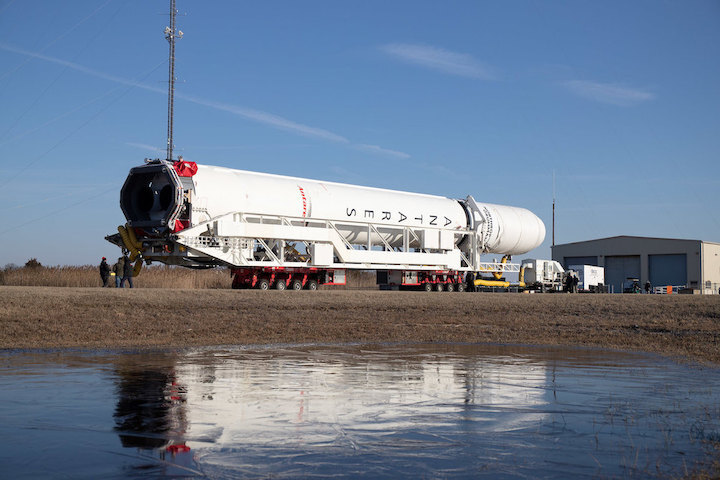
An Antares rocket and Cygnus spacecraft are set for launch Saturday on Northrop Grumman’s 17th resupply mission to the International Space Station, hauling more than 8,000 pounds of research experiments and cargo from a launch pad in Virginia.
Ground crews at the Mid-Atlantic Regional Spaceport, located at NASA’s Wallops Flight Facility on Virginia’s Eastern Shore, spent Friday loading time-sensitive cargo into the Cygnus spacecraft at the launch pad. With the final cargo load complete, teams began steps to close the forward hatch on the Cygnus cargo ship and install the top of the rocket’s nose cone.
Technicians at launch pad 0A planned to raise the 139-foot-tall (42.5-meter) Antares rocket vertical overnight in preparation for the start of the five-hour countdown. Liftoff is set scheduled for 12:40 p.m. EST (1740 GMT) Saturday, the opening of a five-minute launch window.
Forecasters predict a 75% chance of good weather for liftoff of the Antares rocket Saturday.
Two Russian-made RD-181 engines, burning kerosene and liquid oxygen, will fire for 3 minutes, 18 seconds, to send the Cygnus cargo ship into space. The Antares rocket will shed its first stage, payload fairing, and interstage adapter before igniting a solid-fueled Castor 30XL second stage motor to inject the Cygnus spacecraft into orbit.
The Antares upper stage will deploy the Cygnus spacecraft in a preliminary parking orbit at T+plus 8 minutes, 49 seconds. The Cygnus spacecraft will unfurl its fan-shaped solar arrays within the first few hours of the mission.
A series of thruster burns will guide the Cygnus spacecraft toward the space station, culminating in the supply ship’s capture by the space station robotic arm at 4:35 a.m. EST (0935 GMT) Monday, assuming an on-time launch Saturday.

NASA astronauts Raja Chari and Kayla Barron will operate the space station’s Canadian-built robotic arm to catch the unpiloted Cygnus spacecraft as it floats just 30 feet, or abut 10 meters, below the complex.
Ground teams will command the robotic arm to move the Cygnus spacecraft to an attach point on the space station’s Unity module, where it will stay around three months.
The Cygnus supply freighter will be the second cargo ship to arrive at the space station in less than a week, following the successful docking of Russia’s Progress MS-19 spacecraft at the complex Thursday.
The Cygnus mission, designated NG-17, will deliver more than 8,300 pounds (about 3,800 kilograms) of cargo to the space station.. Here’s a breakdown of the NG-17 cargo manifest:
• 2,980 pounds (1,352 kilograms) of crew supplies
• 2,883 pounds (1,308 kilograms) of vehicle hardware
• 1,975 pounds (896 kilograms) of science investigations
• 200 pounds (100 kilograms) of unpressurized cargo
• 132 pounds (60 kilograms) of spacewalk equipment
• 77 pounds (35 kilograms) of computer resources
NASA has multibillion-dollar contracts with Northrop Grumman, SpaceX, and Sierra Nevada Corp. to ferry cargo to and from the space station. Northrop Grumman’s two resupply contracts cover 19 operational cargo missions through 2023.
The Cygnus spacecraft flying on Northrop Grumman’s NG-17 mission is named for Piers Sellers, an astronaut and NASA research scientist who died from cancer in 2016. Northrop Grumman announced the spacecraft would be nicknamed “S.S. Piers Sellers” ahead of this weekend’s launch.

The NG-17 mission will carry hardware for the space station’s life support systems, and support equipment to prepare for the arrival of new roll-out solar arrays at the space station on a future SpaceX cargo mission. The new solar arrays are smaller and more efficient than the station’s existing, aging, and degrading solar panels.
The Cygnus spacecraft will deliver a deployer from Nanoracks to jettison and dispose of the space station’s trash through the company’s commercial Bishop airlock.
Along with spare parts and equipment to keep the space station running, the Cygnus cargo freighter is packed with more than a ton of scientific research gear.
The experiments heading to the space station on the NG-17 mission include an investigation studying engineered human skin cells to evaluate how they change in microgravity. Deterioration of skin tissue is a normal part of aging. Similar changes occur in the human body in space, but they happen much more quickly.
Researchers will study the skin cells in space in hopes of using them as a model to assess products to protect against skin damage from aging back on Earth.
The Cygnus mission will also carry to the space station a combustion experiment to assess the flammability of different types of materials that could be used on future space missions, such as human expeditions to the moon and Mars.
There is also a technology demonstration experiment to evaluate new sensors that can better detect hydrogen generated as a byproduct of the space station’s oxygen generation system.
Another experiment will look into using hydroponic, or water-based, and aeroponic, or air-based techniques to grow plants on the space station. Astronauts so far have used conventional soil to grow vegetables on the station, but hydroponic and aeroponic systems could offer advantages in size and mass for future missions into deep space.
The Cygnus spacecraft will also launch with a Japanese tech demo of a new lithiun-ion battery that could be used on future space missions, plus two CubeSats for deployment from the space station’s Kibo module and outside the Cygnus cargo ship itself in the next few months.
Quelle: SN
+++
NASA TV Coverage of NASA’s Northrup Grumman Cargo Resupply Mission

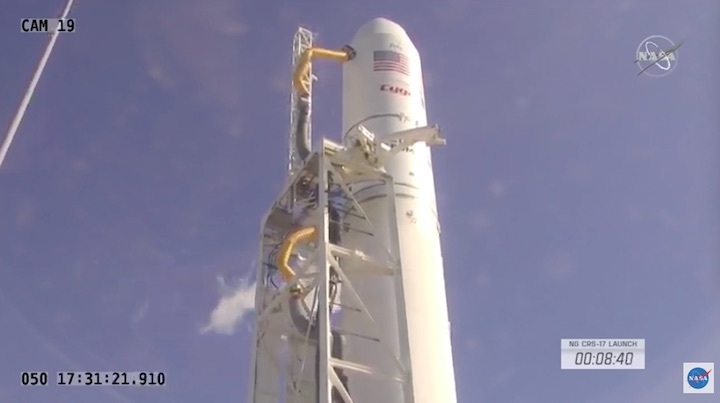





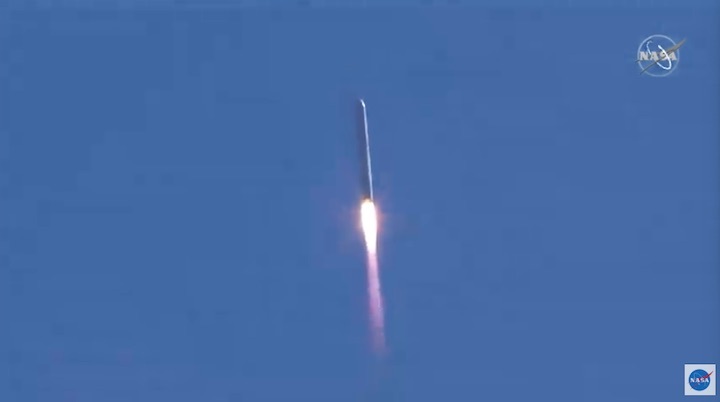

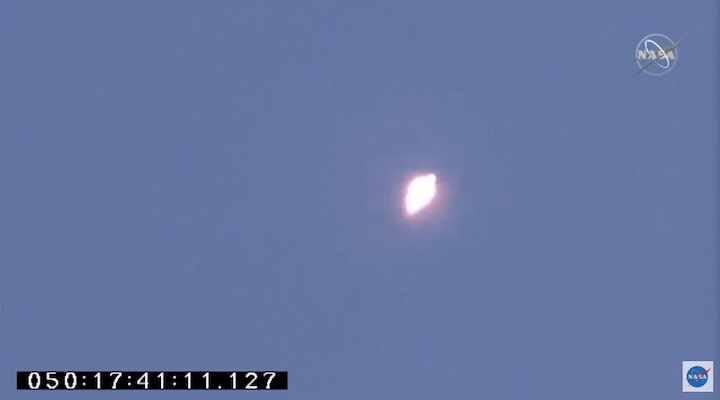

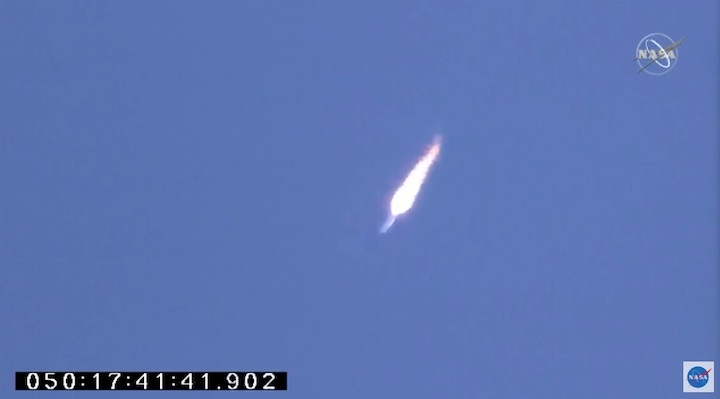

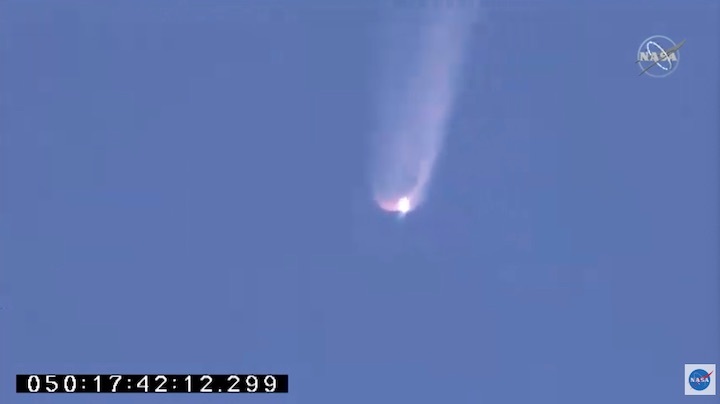
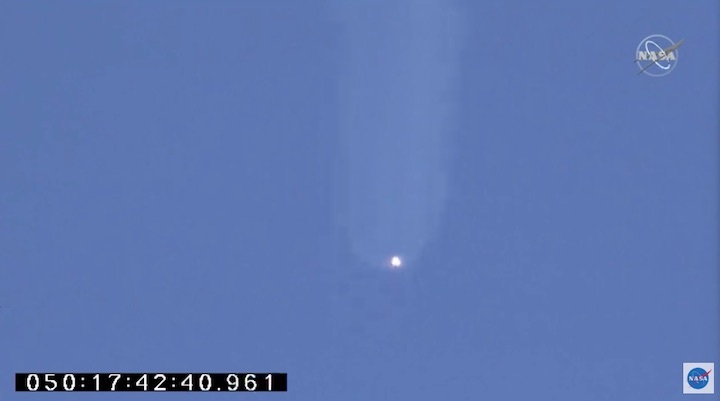




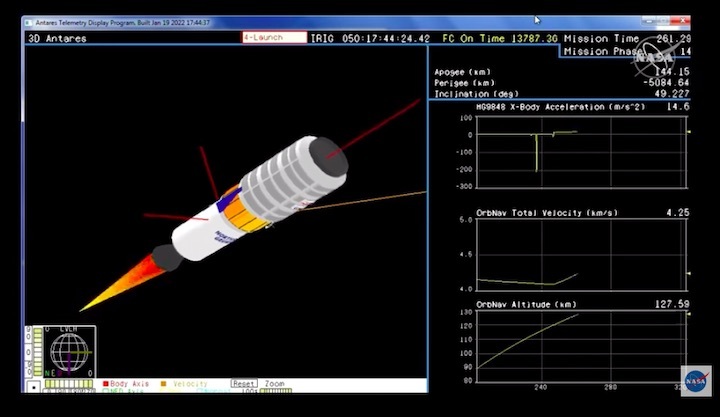




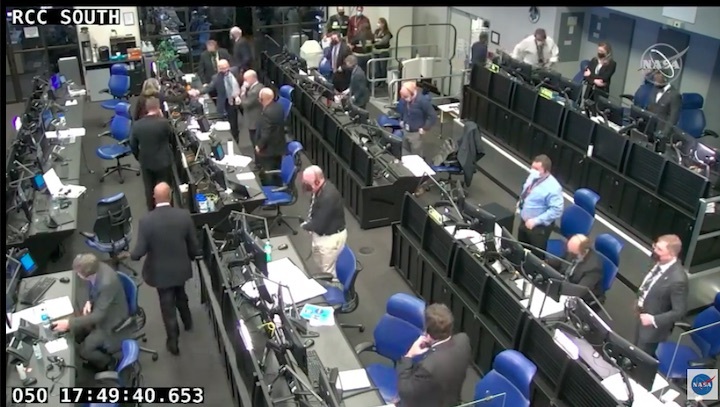

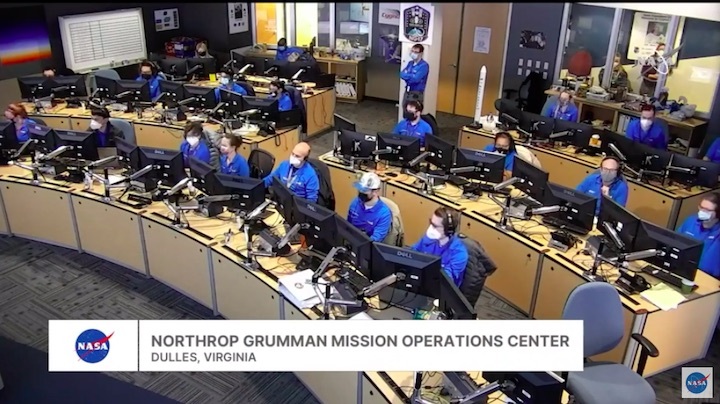
Quelle: NASA
----
Update: 20.02.2022
.
A fresh supply of 8,300 pounds of scientific investigations and cargo launched from NASA’s Wallops Flight Facility in Virginia at 12:40 p.m. EST on Saturday, Feb. 19, aboard a Northrop Grumman Cygnus resupply spacecraft, and is now traveling to the International Space Station.
The Cygnus spacecraft, which was launched on an Antares rocket, is scheduled to arrive at the space station around 4:35 a.m. on Monday, Feb. 21. NASA Television, the NASA app, and agency’s website will provide live coverage of the spacecraft’s approach and arrival beginning at 3 a.m.
NASA astronauts Raja Chari and Kayla Barron will capture Cygnus with the station’s robotic Canadarm2 upon its arrival. The spacecraft will then be installed on the Earth-facing port of the station’s Unity module.
This is Northrop Grumman’s 17th contracted resupply mission under the second Commercial Resupply Services contract with NASA. The delivery includes critical materials to support dozens of the more than 250 science and research investigations occurring during NASA’s Expedition 66 mission aboard the space station.
The scientific investigations Cygnus is carrying include:
Protecting our skin
Deterioration of skin tissue, a normal part of aging, occurs over decades. Microgravity leads to changes in the body like aging but that occur much more quickly, so they can be more easily studied. Colgate Skin Aging will evaluate cellular and molecular changes in engineered human skin cells in microgravity. Results may help speed development of products aimed at protecting skin from the aging process on Earth.
Testing tumor drugs
MicroQuin 3D Tumor will examine the effects of a therapeutic on breast and prostate cancer cells. These cells can grow in a more natural 3D model in microgravity, which makes it easier to characterize their structure, gene expression, cell signaling, and response to the treatment. Results could provide new insight into the cell protein targeted by the drug and help advance development of other cancer drugs.
Improving hydrogen sensors
The Advanced Hydrogen Sensor Technology Demonstration will test new sensors for the space station’s oxygen generation system. Current sensors ensure that none of the hydrogen enters the cabin oxygen but can be sensitive to moisture, nitrogen, and other issues that require them to be swapped out every 201 days. This technology could provide more durable sensors for situations where rapid replacement is not practical, reducing the number of spares needed on longer space missions such as to the Moon or Mars.
Better batteries
Space Demonstration for All Solid-State Li Ion Battery (Space As-Lib), an investigation from the Japan Aerospace Exploration Agency, will feature the operation of a lithium-ion secondary battery capable of safe, stable operation under extreme temperatures and in a vacuum environment. The battery uses solid, inorganic, and flame-retardant materials that do not leak, making it safer and more reliable. Results could demonstrate the battery’s performance for various potential uses in space and other planetary environments. Solid-state batteries also have potential applications in harsh environments and the automotive and aerospace industries.
Plants in space
Current systems for growing plants in space use soil or a growth medium. These systems are small and do not scale well in a space environment due to mass, containment, maintenance, and sanitation issues. To address these issues, eXposed Root On-Orbit Test System (XROOTS) will use water- and air-based methods instead, reducing overall system mass. Results could provide insight into the development of larger-scale systems to grow food crops for future space exploration and habitats. Components of the system could also enhance plant cultivation in greenhouses on Earth and contribute to better food security.
Improving fire safety
Solid Fuel Ignition and Extinction (SoFIE) will enable studies of the flammability of materials and ignition of fires in realistic atmospheric conditions. This facility uses the Combustion Integrated Rack (CIR), which allows for testing at different oxygen concentrations and pressures that represent current and planned space exploration missions. Gravity influences flames on Earth, but in microgravity, fire acts differently and can behave in unexpected ways aboard the space station. Some evidence suggests that fires may be more hazardous in reduced gravity. Results could help ensure crew safety by improving design of extravehicular activity suits, and cabin materials, improve our ability to determine the best techniques for suppressing fires in space.
Findings from these and other investigations aboard the space station will contribute to keeping astronauts healthy during long-duration space travel and demonstrate technologies for future human and robotic exploration missions as part of NASA’s Moon and Mars efforts, including lunar missions through the agency’s Artemis program.
Cygnus will also deliver critical hardware to be installed during the upcoming ISS Roll-Out Solar Array (IROSA) spacewalks, as well as other components for the successful functioning of astronaut life on the space station, such as a trash deployer and acoustic covers for the waste management system.
This Cygnus mission is the first to feature enhanced capabilities that will allow the spacecraft to perform a reboost, using its engines to adjust the space station’s orbit as a standard service for NASA. The agency has one reboost is planned while Cygnus is connected to the orbiting laboratory. A test of the maneuver was performed in 2018 during Cygnus’ ninth resupply mission.
Cygnus will remain at the space station until May before it deploys CubeSats, then disposes of several thousand pounds of trash during its re-entry into Earth’s atmosphere, which will result in its destruction.
Quelle: NASA

